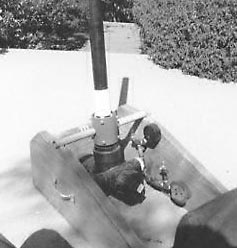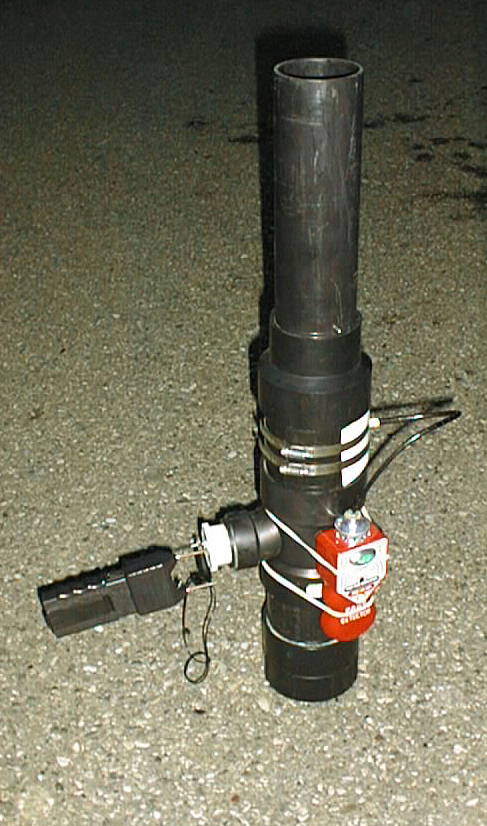The following is my attempt at writing a FAQ for would-be spudsters. For more information, consult the links at the bottom of this page.
First, a bit of...
Potato guns, tennis-ball launchers and other explosive devices seem to have been around since the invention of the tube. The earliest reference this author has found is the the lighter-fluid propelled "Colorado Goose Gun", known to have been built in central California as far back as the '60s. This device consisted of a series of steel beverage cans connected in series with tape. The ends were removed from all but the bottom can, which had a small hole punched in its bottom and several "church-key" punches ringing its top, which was taped to the other cans.
The introduction of plastic pipe fittings was many decades ago. PVC offers many advantages over metal cans. The smooth inner surfaces, coupled with the ease of working the material with just a hacksaw and a bottle of glue, as well as the standardization of sizes are the most obvious. Curiously, the first references of the use of PVC fittings to make launchers is less than 5 years old. Once these devices appeared however, the spread of the technology was fairly rapid.
Once the principles were generally known, it was only a matter of time before a crime was committed with one of these formidable force-multipliers. It was no surprise, therefore, when it happened in Oakland in 1993. Bad luck all around with that: the perp was a car-jacker and using a potato gun fueled with hairspray he took a shot at a passing car. The driver's window was smashed, the fellow lost control of the car, which struck a pole. The driver was killed and the charge was murder. After the uproar that followed, potato gun ownership was made a crime, equivalent to possession of a sawed-off shotgun.
However, owing to the availability of parts to the general populace, and to the tendency of folks to want to have a bit of mindless fun, these devices have continued to increase in number. Enforcement has been spotty at best, meaning in most instances, enlightened gendarmes have either tolerated the operation of such devices, or have at most confiscated them. But there have been extreme reactions, where some particularly nasty law enforcement types have decided to make an example of the hapless owner. The moral of the story is: your mileage may vary. How well do you know the people who are holding your leash??
In the spirit of abiding by the law as it stands, all of the information pertaining to the construction of these devices that follows should be considered historical in nature: this is the way it WAS done, way back when, NOT the way you should do it now. The author in no way wishes to endorse the construction, use or ownership of ANY of these devices for any other purpose than scientific curiosity: enlightened awareness of the hows, whys and processes of the physical world can enhance one's enjoyment of our trek to oblivion. I support the notion that things are worth trying in order to learn a bit of science, but never to gain unfair advantage. Any idiot can buy a gun. Many do.
In an attempt to minimize risk, since this author realizes that people will build these things anyway, the following FAQ includes as many caveats as were known as well as a series of "DON'Ts" which cover many, but certainly not all, of the mistakes that can lead to misfortune. Common sense is merely common, not pervasive. Damned fools will be with us until the end of time. This document has been written in an attempt to minimize this propensity.
First and foremost,
-DO good science: keep track of what you do and
-DO NOT change more than one variable at a time!
-DO NOT point a spud gun at a living creature
-DO NOT fire a spud gun on a windy day
-DO NOT fire a spud gun at night, or on any but clear, sunny days
-DO NOT shoot at aircraft, or when aircraft are nearby
-DO NOT shoot at a fence: a spud gun can fire a spud clean through and produce lots of FAST, deadly splinters, to boot
-DO NOT store a spud gun with less than two ports open
-DO NOT look down the barrel, or blow down the barrel to purge exhaust
-DO NOT use acetylene: it's nasty stuff!
-DO NOT use gunpowder
-DO NOT attempt to rifle the barrel: this weakens the structure.
-DO NOT shoot marbles, golf balls or anything harder or sharper than a tuber
-DO NOT ---well, make up your own and TELL ME, so I can circulate it!!!
-ALWAYS drill a vent-hole somewhere in the combustion chamber, to act as a hang-fire relief-valve. Unscrewing a large diameter plug once detonation has occurred is deadly.
-If you can, use an electronic detonator, similar to those used in model rocketry. Make an extension cord so you don't have to stand right next to the spud gun when you fire it.
-MAKE SURE that there aren't any "downwinders" for 1/2 MILE
-REMEMBER the muzzle velocity of a spud can approach 400ft./sec. A potato has much more mass than a large caliber bullet. Do a bit of math and you will see that a potato has as much or more kinetic energy than a .45 cal. bullet!
--Handsaw or hacksaw to cut the pipe
--Round file to de-burr inside edges
--Flat file to de-burr outside edges and to make a flat, thin spot on the side of the
tee (for the igniter)
--Rags to clean pipe THOROUGHLY before gluing up
--Pocket knife to carve 'taters to fit barrel
--Mallet to drive 'taters into the barrel for tight fit
--1/8" drill bit
--1/4" drill bit
--Large flat-bladed screwdriver to tighten the hose clamps
--Tin snips to cut the galvanized mesh
--At this point the gun would be ready to fire!

